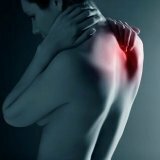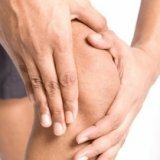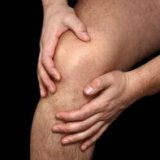Causes of pain in the knees

Pain in the knees is an extremely unpleasant symptom, with which almost half of the adult population is familiar.The prevalence of the pathologies that cause it not only does not decrease, but the year grows year too.In addition, diseases that lead to more or less severe pain rapidly "get younger";Often even teenagers turn to help specialists.
Table of contents: Osteoarthritis of the knee joint Meniscal lesions Arthritis Coxarthrosis Impaired local circulation Inflammation of the periarticular tissues of the knee area Other causesThe most common causes of pain in the knees:
- arthritis;
- meniscopathy;
- gonarthrosis;
- coxarthrosis;
- local circulatory disorders;
- periarthritis;
- injury.
Osteoarthritis of the knee joint
Gonarthrosis is a degenerative-dystrophic disease.It is diagnosed in about 35-40% of people who have consulted a doctor for pain in the knees.This pathology often develops in patients aged 40 years and older, but often young people also need help.The incidence among women is significantly higher than among men of the same age group.The pathological process is primary( idiopathic) or secondary.He is able to affect both one and both extremities.The causes of the appearance of the idiopathic form are not yet clear, and the secondary one arises against the background of the traumas, excessive loads( including excess weight), infections and systemic diseases.
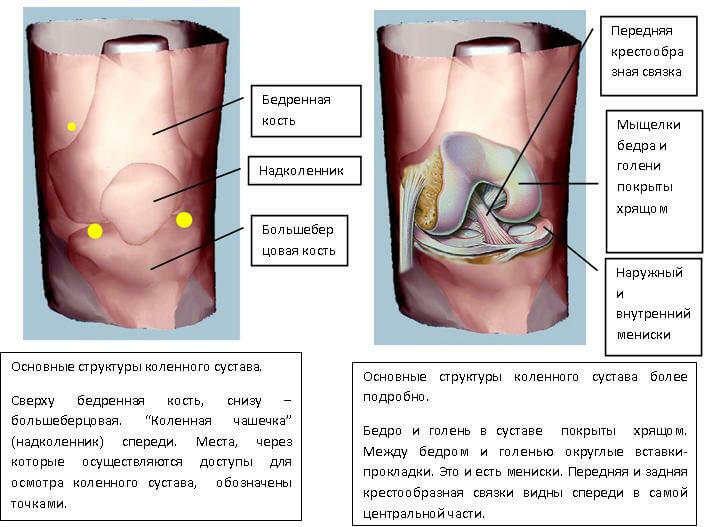
Important! For deforming osteoarthritis, a slow progressive deterioration of the cartilaginous tissue, leading to a change in the knee joint and a violation of its functions, is characteristic.
The disease usually develops over many months and even years.At the initial stages, the pain syndrome is rather weak, and appears only against a background of considerable physical exertion - for example, after a long walk or sports training.At rest, it passes quickly enough, and analgesics are not required.The patient often does not give pain to special significance, writing off problems for natural fatigue.
As the pathology develops, the pain becomes more intense, and manifests itself after walking for short distances.Squatting and climbing a flight of stairs become a serious problem for a person.During the rest of the spontaneous appearance of pain is not noted, and at night she does not bother( except when during the day the load on the aching leg was very significant).
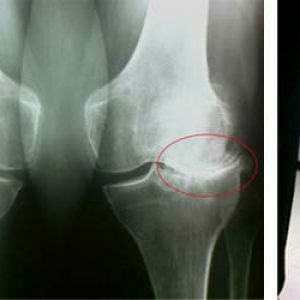 At the next stage, another characteristic symptom is added: a crunch in the knee caused by deformation of the articular surfaces.The change in the shape of the joint is revealed by radiography and can be determined visually.The pain often starts to bother even in a state of rest, and hardly is stopped by usual analgesic preparations.Mobility in the joint( amplitude of movements) is markedly reduced.
At the next stage, another characteristic symptom is added: a crunch in the knee caused by deformation of the articular surfaces.The change in the shape of the joint is revealed by radiography and can be determined visually.The pain often starts to bother even in a state of rest, and hardly is stopped by usual analgesic preparations.Mobility in the joint( amplitude of movements) is markedly reduced.
In the absence of adequate and comprehensive treatment, clinical manifestations tend to progress over time.A possible outcome of the disease can be almost complete loss of mobility in the joint and disability of the patient.
Important: on the background of arthrosis may damage adipose tissue.The pathology, called "Hoff's disease," is manifested by pain and swelling, and weakening of the quadriceps muscle of the thigh.
Meniscus lesions
Meniscopathies, which are inherently an injury, cause pain in the knees in 30-40% of cases.Pathology is diagnosed in people of all age categories.The knee joint of one limb usually suffers;Symmetrical lesions are diagnosed in rare cases.Meniscal lesions are very typical for professional athletes and fans of all kinds of "extreme".
Please note: menisci are original cartilaginous pads joined together by a transverse ligament.When driving, they take on the function of shock absorbers.
Meniscopathies develop rapidly.Their immediate cause are unsuccessful movements and falls.At the time of injury, the patient experiences a characteristic crunch and severe acute pain.A person is temporarily deprived of the ability to move independently, because even a minimal load on the injured limb leads to a sharp increase in the pain syndrome.After a while( 20-30 minutes) the pain syndrome weakens, and the patient can walk a short distance alone.But after a day or two the knee area swells, and when walking there is a strong piercing pain and the feeling that the leg is now "broken" in the knee.
The duration of the acute phase is on average 2-3 weeks, after which a remission occurs.If adequate measures are not taken, the process is chronic, and the disease lasts for years.Squats, long walks or unsuccessful movements provoke an exacerbation of meniscopathy.The disease itself is not accompanied by deformation of the osseous structures, but over time, the development of gonarthrosis is possible.Meniscus ruptures often become an indication for surgical intervention.

Arthritis
Joint inflammation is found on average in 7-8% of patients who suffer from pain in the knees.The disease can be diagnosed at any age, but so-called."Debut" in most cases falls on young years( with the exception of gout).The inflammatory process affects one or both legs.
The most commonly diagnosed types of arthritis:
- rheumatoid( autoimmune process);
- gouty( against the background of metabolic disorders);
- is psoriatic( with psoriasis disease).
A specific feature of arthritis is its rapid development( within 1-3 days).Typical clinical signs of the inflammatory process are intense pain, severe puffiness in the projection of the affected joint and restriction of mobility.The intensity of the pain syndrome, as a rule, increases at night( more often - in the morning).During these hours, pain in rest is often even stronger than with loads.
Important: nocturnal knee pain is also noted in osteoarthrosis and meniscus lesions.But with these pathologies, the pain syndrome is the result of unsuccessful movements or an uncomfortable position of the limb.It is almost impossible to get rid of pains against arthritis simply by changing the position of the body - in this case, the condition is facilitated only by taking strong analgesics or anti-inflammatory drugs.
In arthritis, other joints of the limbs are often involved in the process.In particular, when gout is primarily affected by the joints of the fingers and ankle, and only with the progression of the process inflamed knee.
Coxarthrosis
In some cases, patients who complain of knee pain are diagnosed with "arthrosis of the hip joint".With this pathology, the pains have the ability to irradiate( "give") to the knee area.Differential diagnosis of gonarthrosis and coxarthrosis usually presents no difficulties;In the second case the mobility in the knee joint is absolutely normal, but in the hip joint it is essentially limited.
Violations of the local circulation
The so-called "vascular pain" is detected in about one in ten, turned to an expert artrologist for help.Insufficiency of blood circulation in the knee joints often first appears during adolescence, when there is active growth and hormonal changes in the body.
The reason lies in the fact that the development of blood vessels often lags behind the growth of cartilaginous and bone tissue.In many patients, local blood circulation comes back to normal as the growth ends, but in a number of cases the problem remains for life.The intensity of periodic pain and the frequency of their occurrence decrease by 18-24 years.Mobility in the knee joint with vascular disorders does not suffer.
Pain against the background of circulatory failure is characterized by symmetry.They have the property to intensify against the background of catarrhal and infectious diseases, after significant loads on the lower extremities, as well as with changing weather( or changing climatic zones).In such cases, active local massage( rubbing) and topical topical products( ointments and gels with a warming effect) are good.These methods contribute to the stimulation of blood flow, i.e., the effect on the root cause of the pain syndrome is realized.
Inflammation of the periarticular tissues of the knee region
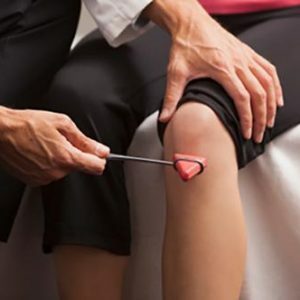 Periarthritis is a disease of inflammatory genesis that affects the periarticular tissues, in particular, the goose paw bag.The process captures not only the tendons and their synovial vaginas, but often also the joint capsule.An impetus to the development of pathology can be transferred infections, severe hypothermia and regular long stay in damp premises.
Periarthritis is a disease of inflammatory genesis that affects the periarticular tissues, in particular, the goose paw bag.The process captures not only the tendons and their synovial vaginas, but often also the joint capsule.An impetus to the development of pathology can be transferred infections, severe hypothermia and regular long stay in damp premises.
From the periarthritis of the knee area are more likely to suffer from representatives of the weaker sex at the age of 45 years and older.Pain syndrome usually develops after descending stairs or lifting weights.Against the background of usual loads( walking at an average pace), pain, as a rule, does not appear.
Pain syndrome with inflammation of the goose pouch bag is characterized by a clear localization.The amplitude of movements in the knee joint for this disease is not limited, swelling( swelling) and deformity are not detected.
Other causes
Pain in the knees always occurs when the is severely bruised .Blunt trauma of the tissues is accompanied by swelling, restriction of mobility and the appearance of bruises( bruises) on the skin at the site of the bruise.In some cases, intra-articular hemorrhage is possible.In most cases, patients are shown conservative treatment.
A much more serious injury is the rupture of the ligaments.It is characterized by a sharp increase in the intensity of the pain syndrome when trying to deploy the shin to the inside.With complete rupture of ligaments, there is pathological mobility( "loosening up") in the joint.
Among the fairly common causes of pain in the knees are bursitis ( inflammation of the articular bags) and tendiditis ( inflammation of the tendons).Pain in these pathologies has the property of increasing on palpation;The amplitude of movements in the affected joint is severely limited.
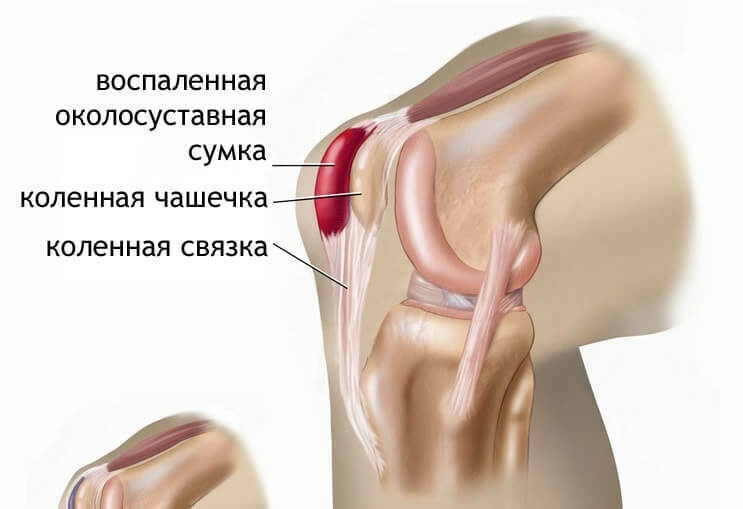
If there is pain of moderate intensity and decreased mobility in the knee, it may be about synovitis - inflammation of the synovial membranes.
After traumatic lesions it is possible to form a dense neoplasm localized on the posterior surface of the knee joint - so-called. cysts Baker .The disease is characterized by soreness in movement and a sensation of tingling and a decrease in the sensitivity of the skin below the cyst.
"Shooting" pain, which is accompanied by a decrease in the knee reflex and paresthesia( impaired sensitivity), is usually a clinical manifestation of sciatic nerve neuropathy.
Adolescents( often boys) aged 12-16 years sometimes develop osteohodropatia tuberosity of the tibia.With this pathology, known as the Osgood-Schlatter disease , intense pain in the knees appears during physical exertion( including when trying to sit down slightly).In themselves, they are extremely rare.The disease almost completely disappears by 18-20 years.Until the symptoms disappear completely, the patient should not be subjected to a load on his legs.
Against the background of frequent injuries, development of the chondropathy of the patella is possible, manifested by pain in the kneecap, which increases with active movements.Other symptoms of the pathology include a distinct crunch and clicks when bending the leg in the knee.
Acute boring pain, which is accompanied by local swelling, a sharp deterioration in overall health, a rise in body temperature to 40 ° C and myalgia is a symptom of osteomyelitis - purulent necrotic lesion of bone and bone marrow.Pathology is an indisputable indication for urgent hospitalization and surgical treatment.
Plisov Vladimir, medical reviewer

